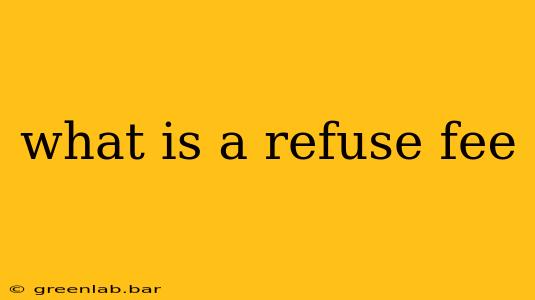Many homeowners and renters are familiar with the monthly or quarterly bill that covers waste disposal, but understanding exactly what comprises that charge can be confusing. One key component often found on these bills is the refuse fee, sometimes called a garbage fee, trash collection fee, or solid waste fee. This article will clarify what a refuse fee is, what it covers, and factors that influence its cost.
Decoding the Refuse Fee: What Does it Cover?
A refuse fee is the charge levied by your local municipality or a private waste management company for the collection and disposal of your household trash. This fee covers the entire process, from curbside pickup to transportation and processing at a landfill, recycling center, or waste-to-energy facility. The services included often encompass:
- Curbside Collection: The regular pickup of your trash and recycling bins from your property. Frequency varies depending on your location—some areas have weekly collections, while others might be bi-weekly or even monthly.
- Transportation to Processing Facilities: The hauling of collected waste to its designated processing location. This involves fuel costs, vehicle maintenance, and driver salaries.
- Processing and Disposal: This step includes sorting recyclable materials, landfilling non-recyclable trash, or processing waste for energy recovery. Costs here are affected by landfill space availability, recycling market fluctuations, and the technologies used for waste processing.
- Administrative Costs: The refuse fee also helps cover the administrative costs associated with billing, customer service, and managing the waste collection program.
Factors Influencing Your Refuse Fee
Several factors can contribute to the amount you pay as a refuse fee:
1. Location:
Your location significantly impacts the cost. Areas with higher populations or limited landfill space generally have higher refuse fees due to increased operational costs and the need for more extensive waste management infrastructure. Rural areas may have lower fees due to lower population density and potentially different waste disposal methods.
2. Service Level:
The type of service provided affects the cost. For instance, areas offering specialized programs like bulky waste pickup, yard waste collection, or hazardous waste disposal may charge higher refuse fees to cover these additional services. Some communities offer tiered service levels, allowing residents to choose different bin sizes or collection frequencies, impacting the final fee.
3. Waste Disposal Method:
The method used to dispose of the waste plays a key role. Landfills are a common method, but others include incineration (waste-to-energy) and composting. Each method has associated costs, and these costs are reflected in the refuse fee.
4. Economic Conditions:
Fuel prices, labor costs, and the cost of materials used in waste management operations directly affect refuse fees. Economic fluctuations can cause these costs to rise, leading to an increase in the refuse fee.
Understanding Your Bill and Potential for Savings
Carefully review your refuse bill to understand the specific components of the fee. Contact your local municipality or waste management company if you have any questions or need clarification. Explore opportunities for reducing your waste and increasing recycling to potentially lower your environmental impact and, depending on your local program, your overall refuse fee.
Disclaimer: This information is intended for general knowledge and informational purposes only, and does not constitute financial or legal advice. Always consult with your local municipality or waste management provider for precise details regarding your refuse fee and associated services.

